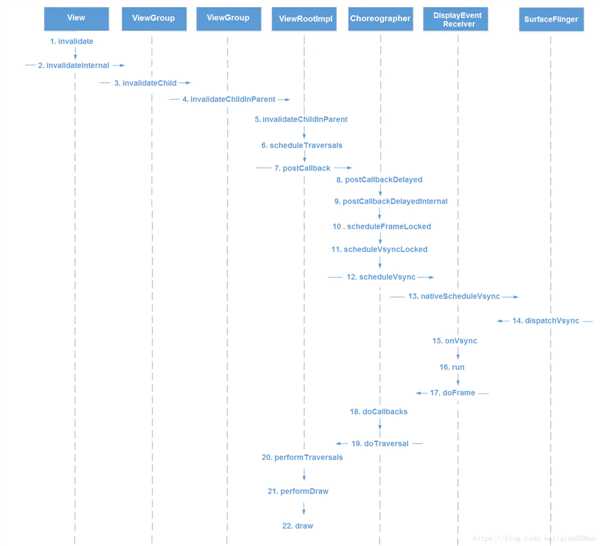标签:gpu action 学习 统一 表示 with view clock value
屏幕的刷新包括三个步骤:
View 发起刷新的操作时,最终是走到了 ViewRootImpl 的 scheduleTraversals() 里去,然后这个方法会将遍历绘制 View 树的操作 performTraversals() 封装到 Runnable 里,传给 Choreographer,以当前的时间戳放进一个 mCallbackQueue 队列里,然后调用了 native 层的方法向底层注册监听下一个屏幕刷新信号事件。
当下一个屏幕刷新信号发出的时候,如果对这个事件进行监听,那么底层会回调 onVsync() 方法来通知。当 onVsync() 被回调时,会发一个 Message 到主线程,将后续的工作切到主线程来执行。切到主线程的工作就是去 mCallbackQueue 队列里根据时间戳将之前放进去的 Runnable 取出来执行,而这些 Runnable 就是遍历绘制 View 树的操作 performTraversals()。遍历操作完成后,就会去绘制那些需要刷新的 View。
当我们调用了 invalidate(),requestLayout(),等之类刷新界面的操作时,并不是马上就会执行这些刷新的操作,而是通过 ViewRootImpl 的 scheduleTraversals() 先向底层注册监听下一个屏幕刷新信号事件,然后等下一个屏幕刷新信号来的时候,才会去通过 performTraversals() 遍历绘制 View 树来执行这些刷新操作。
导致界面刷新丢帧的原因有两类:一是遍历绘制 View 树计算屏幕数据的时间超过了 16.6ms;二是,主线程一直在处理其他耗时的消息,导致遍历绘制 View 树的工作迟迟不能开始,从而超过了 16.6 ms 底层切换下一帧画面的时机。第一个原因是因为我们写的布局有问题,需要进行优化了。而第二个原因则是我们常说的避免在主线程中做耗时的任务。针对第二个原因,系统已经引入了同步屏障消息的机制,尽可能的保证遍历绘制 View 树的工作能够及时进行,但仍没办法完全避免,所以我们还是得尽可能避免主线程耗时工作。
Choreographer机制,用于同Vsync机制配合,统一动画、输入和绘制的时机。
本节讲解Choreographer机制主要是从绘制方面做阐述,界面的绘制要从ViewRootImpl的requestLayout开始说起,其源码如下:
@Override public void requestLayout() { if (!mHandlingLayoutInLayoutRequest) { checkThread(); // 检查是否在UI线程 mLayoutRequested = true; // 是否进行measure和layout布局 scheduleTraversals(); } } void scheduleTraversals() { if (!mTraversalScheduled) { mTraversalScheduled = true; // 拦截同步消息 mTraversalBarrier = mHandler.getLooper().getQueue().postSyncBarrier(); // 执行绘制操作 mChoreographer.postCallback(Choreographer.CALLBACK_TRAVERSAL, mTraversalRunnable, null); if (!mUnbufferedInputDispatch) { scheduleConsumeBatchedInput(); } notifyRendererOfFramePending(); pokeDrawLockIfNeeded(); } }
这里需要注意的地方有两点:
Choreographer的创建是在ViewRootImpl的构造函数中。
public ViewRootImpl(Context context, Display display) { mContext = context; mWindowSession = WindowManagerGlobal.getWindowSession(); ... mChoreographer = Choreographer.getInstance(); ... }
下面是Choreographer的getInstance执行的代码:
/** * Gets the choreographer for the calling thread. Must be called from * a thread that already has a {@link android.os.Looper} associated with it. * * @return The choreographer for this thread. * @throws IllegalStateException if the thread does not have a looper. */ public static Choreographer getInstance() { return sThreadInstance.get(); } // Thread local storage for the choreographer. private static final ThreadLocal<Choreographer> sThreadInstance = new ThreadLocal<Choreographer>() { @Override protected Choreographer initialValue() { Looper looper = Looper.myLooper(); if (looper == null) { throw new IllegalStateException("The current thread must have a looper!"); } Choreographer choreographer = new Choreographer(looper, VSYNC_SOURCE_APP); if (looper == Looper.getMainLooper()) { mMainInstance = choreographer; } return choreographer; } }; private static volatile Choreographer mMainInstance;
可以看到每一个Looper线程都有自己的Choreographer,其他线程发送的回调只能运行在对应Choreographer所属的Looper线程上。
这里我们再看一下Choreographer的构造函数:
private Choreographer(Looper looper, int vsyncSource) { mLooper = looper; mHandler = new FrameHandler(looper); mDisplayEventReceiver = USE_VSYNC ? new FrameDisplayEventReceiver(looper, vsyncSource) : null; mLastFrameTimeNanos = Long.MIN_VALUE; mFrameIntervalNanos = (long)(1000000000 / getRefreshRate()); mCallbackQueues = new CallbackQueue[CALLBACK_LAST + 1]; for (int i = 0; i <= CALLBACK_LAST; i++) { mCallbackQueues[i] = new CallbackQueue(); } // b/68769804: For low FPS experiments. setFPSDivisor(SystemProperties.getInt(ThreadedRenderer.DEBUG_FPS_DIVISOR, 1)); }
Choreographer类中有一个Looper和一个FrameHandler变量。变量USE_VSYNC用于表示系统是否是用了Vsync同步机制,该值是通过读取系统属性debug.choreographer.vsync来获取的。如果系统使用了Vsync同步机制,则创建一个FrameDisplayEventReceiver对象用于请求并接收Vsync事件,最后Choreographer创建了一个大小为3的CallbackQueue队列数组,用于保存不同类型的Callback。
不同类型的Callback包括如下4种:
CALLBACK_INPUT、CALLBACK_ANIMATION、CALLBACK_TRAVERSAL、CALLBACK_COMMIT。

CallbackQueue是一个容量为4的数组,每一个元素作为头指针,引出对应类型的链表,4种事件就是通过这4个链表来维护的。而FrameHandler中主要处理三类消息:
private final class FrameHandler extends Handler { public FrameHandler(Looper looper) { super(looper); } @Override public void handleMessage(Message msg) { switch (msg.what) { case MSG_DO_FRAME: doFrame(System.nanoTime(), 0); break; case MSG_DO_SCHEDULE_VSYNC: doScheduleVsync(); // 请求VSYNC信号 break; case MSG_DO_SCHEDULE_CALLBACK: doScheduleCallback(msg.arg1); break; } } }
执行流程就要需要从下面的代码开始说起:
// 执行绘制操作 mChoreographer.postCallback(Choreographer.CALLBACK_TRAVERSAL, mTraversalRunnable, null);
最终会调到 postCallbackDelayedInternal 方法:
private void postCallbackDelayedInternal(int callbackType, Object action, Object token, long delayMillis) { synchronized (mLock) { // 当前时间 final long now = SystemClock.uptimeMillis(); // 回调执行时间,为当前时间加上延迟的时间 final long dueTime = now + delayMillis; // obtainCallbackLocked会将传入的3个参数转换为CallbackRecord,然后CallbackQueue根据回调类型将CallbackRecord添加到链表上。 mCallbackQueues[callbackType].addCallbackLocked(dueTime, action, token); if (dueTime >= now) { // 如果delayMillis=0的话,dueTime=now,则会马上执行 scheduleFrameLocked(now); } else { // 如果dueTime > now,则发送一个what为MSG_DO_SCHEDULE_CALLBACK类型的定时消息,等时间到了再处理,其最终处理也是执行scheduleFrameLocked(long now)方法 Message msg = mHandler.obtainMessage(MSG_DO_SCHEDULE_CALLBACK, action); msg.arg1 = callbackType; msg.setAsynchronous(true); mHandler.sendMessageAtTime(msg, dueTime); } } }
mCallbackQueues先把对应的callback添加到链表上来,然后判断是否有延迟,如果没有则会马上执行scheduleFrameLocked,如果有,则发送一个what为MSG_DO_SCHEDULE_CALLBACK类型的定时消息,等时间到了再处理,其最终处理也是执行scheduleFrameLocked(long now)方法。
private void scheduleFrameLocked(long now) { if (!mFrameScheduled) { mFrameScheduled = true; if (USE_VSYNC) { // 如果使用了VSYNC,由系统值确定 if (DEBUG_FRAMES) { Log.d(TAG, "Scheduling next frame on vsync."); } if (isRunningOnLooperThreadLocked()) { // 请求VSYNC信号,最终会调到Native层,Native处理完成后触发FrameDisplayEventReceiver的onVsync回调,回调中最后也会调用doFrame(long frameTimeNanos, int frame)方法 scheduleVsyncLocked(); } else { // 在UI线程上直接发送一个what=MSG_DO_SCHEDULE_VSYNC的消息,最终也会调到scheduleVsyncLocked()去请求VSYNC信号 Message msg = mHandler.obtainMessage(MSG_DO_SCHEDULE_VSYNC); msg.setAsynchronous(true); mHandler.sendMessageAtFrontOfQueue(msg); } } else { // 没有使用VSYNC final long nextFrameTime = Math.max( mLastFrameTimeNanos / TimeUtils.NANOS_PER_MS + sFrameDelay, now); if (DEBUG_FRAMES) { Log.d(TAG, "Scheduling next frame in " + (nextFrameTime - now) + " ms."); } // 直接发送一个what=MSG_DO_FRAME的消息,消息处理时调用doFrame(long frameTimeNanos, int frame)方法 Message msg = mHandler.obtainMessage(MSG_DO_FRAME); msg.setAsynchronous(true); mHandler.sendMessageAtTime(msg, nextFrameTime); } } }
判断USE_VSYNC,如果使用了VSYNC,走scheduleVsyncLocked,即请求VSYNC信号,最终调用doFrame;如果没使用VSYNC,则通过异步Message执行doFrame。
下面我们看一下doFrame的代码:
void doFrame(long frameTimeNanos, int frame) { final long startNanos; synchronized (mLock) { if (!mFrameScheduled) { return; // mFrameScheduled=false,则直接返回。 } long intendedFrameTimeNanos = frameTimeNanos; //原本计划的绘帧时间点 startNanos = System.nanoTime();//保存起始时间 //由于Vsync事件处理采用的是异步方式,因此这里计算消息发送与函数调用开始之间所花费的时间 final long jitterNanos = startNanos - frameTimeNanos; //如果线程处理该消息的时间超过了屏幕刷新周期 if (jitterNanos >= mFrameIntervalNanos) { //计算函数调用期间所错过的帧数 final long skippedFrames = jitterNanos / mFrameIntervalNanos; //当掉帧个数超过30,则输出相应log if (skippedFrames >= SKIPPED_FRAME_WARNING_LIMIT) { Log.i(TAG, "Skipped " + skippedFrames + " frames! " + "The application may be doing too much work on its main thread."); } final long lastFrameOffset = jitterNanos % mFrameIntervalNanos; frameTimeNanos = startNanos - lastFrameOffset; //对齐帧的时间间隔 } //如果frameTimeNanos小于一个屏幕刷新周期,则重新请求VSync信号 if (frameTimeNanos < mLastFrameTimeNanos) { scheduleVsyncLocked(); return; } mFrameInfo.setVsync(intendedFrameTimeNanos, frameTimeNanos); mFrameScheduled = false; mLastFrameTimeNanos = frameTimeNanos; } try { Trace.traceBegin(Trace.TRACE_TAG_VIEW, "Choreographer#doFrame"); //分别回调CALLBACK_INPUT、CALLBACK_ANIMATION、CALLBACK_TRAVERSAL事件 mFrameInfo.markInputHandlingStart(); doCallbacks(Choreographer.CALLBACK_INPUT, frameTimeNanos); mFrameInfo.markAnimationsStart(); doCallbacks(Choreographer.CALLBACK_ANIMATION, frameTimeNanos); mFrameInfo.markPerformTraversalsStart(); doCallbacks(Choreographer.CALLBACK_TRAVERSAL, frameTimeNanos); doCallbacks(Choreographer.CALLBACK_COMMIT, frameTimeNanos); } finally { Trace.traceEnd(Trace.TRACE_TAG_VIEW); } }
doCallBacks里的run方法执行了,也就是真正执行了View的绘制流程了。
1). Choreographer支持4种类型事件:输入、绘制、动画、提交,并通过postCallback在对应需要同步vsync进行刷新处进行注册,等待回调。
2). Choreographer监听底层Vsync信号,一旦接收到回调信号,则通过doFrame统一对java层4种类型事件进行回调。

参考资料:
https://www.jianshu.com/p/0d00cb85fdf3
https://www.jianshu.com/p/bab0b454e39e
Android Framework 学习(八):屏幕刷新机制
标签:gpu action 学习 统一 表示 with view clock value
原文地址:https://www.cnblogs.com/renhui/p/12965850.html